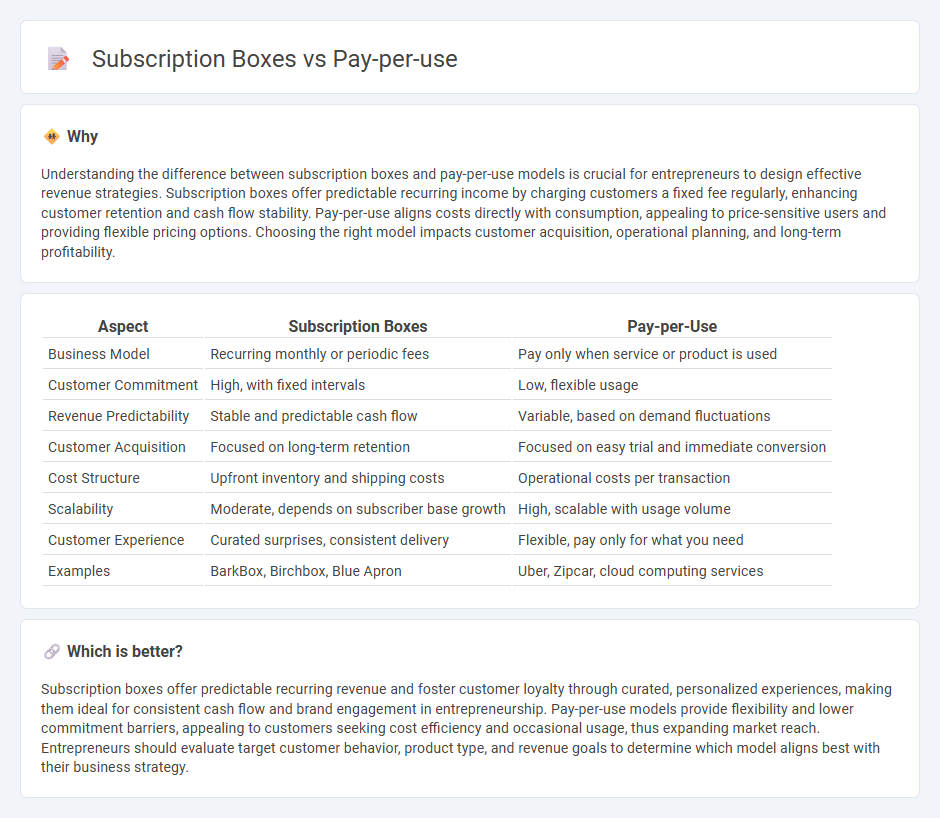
Subscription boxes offer entrepreneurs a steady revenue stream and predictable customer engagement by delivering curated products regularly, enhancing brand loyalty and customer experience. Pay-per-use models provide flexibility and appeal to cost-conscious consumers by charging only for what is used, encouraging trial and minimizing commitment barriers. Explore how these business models can strategically align with your entrepreneurial goals to maximize growth and profitability.
Why it is important
Understanding the difference between subscription boxes and pay-per-use models is crucial for entrepreneurs to design effective revenue strategies. Subscription boxes offer predictable recurring income by charging customers a fixed fee regularly, enhancing customer retention and cash flow stability. Pay-per-use aligns costs directly with consumption, appealing to price-sensitive users and providing flexible pricing options. Choosing the right model impacts customer acquisition, operational planning, and long-term profitability.
Comparison Table
| Aspect | Subscription Boxes | Pay-per-Use |
|---|---|---|
| Business Model | Recurring monthly or periodic fees | Pay only when service or product is used |
| Customer Commitment | High, with fixed intervals | Low, flexible usage |
| Revenue Predictability | Stable and predictable cash flow | Variable, based on demand fluctuations |
| Customer Acquisition | Focused on long-term retention | Focused on easy trial and immediate conversion |
| Cost Structure | Upfront inventory and shipping costs | Operational costs per transaction |
| Scalability | Moderate, depends on subscriber base growth | High, scalable with usage volume |
| Customer Experience | Curated surprises, consistent delivery | Flexible, pay only for what you need |
| Examples | BarkBox, Birchbox, Blue Apron | Uber, Zipcar, cloud computing services |
Which is better?
Subscription boxes offer predictable recurring revenue and foster customer loyalty through curated, personalized experiences, making them ideal for consistent cash flow and brand engagement in entrepreneurship. Pay-per-use models provide flexibility and lower commitment barriers, appealing to customers seeking cost efficiency and occasional usage, thus expanding market reach. Entrepreneurs should evaluate target customer behavior, product type, and revenue goals to determine which model aligns best with their business strategy.
Connection
Subscription boxes and pay-per-use models both offer flexible consumption options that cater to evolving consumer preferences for convenience and personalization. Entrepreneurs leverage subscription boxes to generate predictable recurring revenue while utilizing pay-per-use pricing to attract customers hesitant about commitment, thus broadening market reach. Integrating these approaches enables startups to optimize cash flow, enhance customer loyalty, and adapt quickly to changing demand patterns.
Key Terms
Revenue Model
The pay-per-use revenue model generates income by charging customers based on their actual consumption, allowing flexible spending and reducing upfront commitment, which appeals to price-sensitive consumers. Subscription boxes rely on recurring monthly or quarterly fees, ensuring predictable revenue streams and fostering customer loyalty through curated, personalized experiences. Explore how these models impact profitability and customer retention to choose the right strategy for your business.
Customer Retention
Pay-per-use models offer flexibility and convenience, attracting customers who prefer occasional purchases without long-term commitments. Subscription boxes enhance customer retention by providing curated, recurring experiences that build brand loyalty and habitual engagement. Explore how these approaches impact retention strategies and customer lifetime value in detail.
Scalability
Pay-per-use models offer unparalleled scalability by allowing users to pay only for the resources consumed, making it ideal for fluctuating demand and avoiding fixed costs. Subscription boxes provide predictable revenue streams and customer retention but face limitations in scaling quickly due to inventory and fulfillment constraints. Explore more about how these models impact business growth and operational efficiency.
Source and External Links
What Is Pay-Per-Use? | Revenera - Pay-per-use is a monetization model where customers are charged based on metered access to a product or service, aligning costs with actual consumption and often used in software and SaaS deployments to provide flexibility and clear value-based pricing.
Business Model: Pay-Per-Use - Reason Street - This model charges customers each time they use a service rather than a fixed fee, differing from subscription by allowing payment strictly based on usage, and is also known as usage-based or consumption-based pricing.
Business model: Pay Per Use - Learning Loop - Pay-per-use pricing charges customers for actual usage units, such as per API call or mile driven, requiring easy-to-track metrics and robust billing systems to handle variable charges seamlessly.
 dowidth.com
dowidth.com